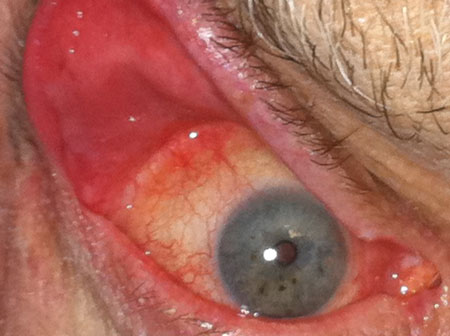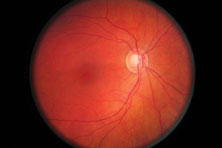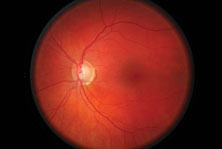Consider sleep apnea in patients with normal tension glaucoma
Click Here to Manage Email Alerts
Worsening of the optic nerve in conjunction with low IOP may indicate normal-tension glaucoma, but it may also signal the presence of underlying sleep apnea.
“The lack of diagnosis of sleep apnea actually places the patient at tremendous risk, both from a cardiac perspective and a psychological perspective,” Primary Care Optometry News Editorial Board member J. James Thimons, OD, said in an interview.
“It is a system-wide disease, affecting the entire body,” he said. “Sleep apnea discovered and treated remarkably reduces the risk of early myocardial infarction and death in young men, and you can actually markedly influence somebody’s lifespan with proper diagnosis.”
“The literature might say sleep apnea occurs in a tiny percentage of people, but that’s because they’re not looking for it,” Allan Panzer, OD, PA, told PCON. “We, as eye care professionals, are in a unique position to diagnose obstructive sleep apnea.”

Floppy lid syndrome is commonly seen in patients with sleep apnea.
Images: Thimons JJ
Panzer said regardless of a patient’s IOP, he will conduct optical coherence tomography, visual field and gonioscopy exams.
“We must first look to the obvious optic nerve evaluation,” he said. “Second, look for hypertension and, third, look to the patient’s symptoms. Often these are otherwise healthy patients who are being treated for hypertension.”
Panzer said if the appearance of the optic nerve indicates glaucoma, if the patient has hypertension and if he or she admits to excessive daytime sleepiness, he will order a sleep study.
“Often they say that their husband or wife has begged them to be tested for years,” he added.
Mechanism of sleep apnea
When oxygen saturation in the blood drops below a critical level, the brain signals the body to “wake up” and take a deep breath, thus preventing deep sleep, according to an Optometric Retina Society (ORS) white paper. This affects the body in two adverse ways: the frequency and magnitude in which oxygen flow to the end organs is compromised and fatigue caused by an inability to reach deep sleep.
Floppy eyelid syndrome, keratoconus
“The mechanism is thought to be similar to the abnormality of collagen that we see in the actual primary disease state where the esophagus is unable to maintain its normal structure during sleep,” Thimons said. “The collagen there is similar to the collagen we see in the eyelid.”


If the appearance of the optic nerve indicates glaucoma, if the patient has hypertension and if he or she admits to excessive daytime sleepiness, the clinician should order a sleep study.
Although the relationship remains unclear, the correlation between floppy eyelid syndrome (FES) and sleep apnea has been well documented and suggests that the associated oxygen deprivation apparent in sleep apnea may lead to increased matrix metalloproteinase, which results in decreased tissue elasticity, the ORS white paper said.
FES is also most commonly associated with obese men, the white paper said.
“Most people with sleep apnea are obese,” Thimons said. “That’s a common correlation.”
He said that the average body mass index in men diagnosed with sleep apnea is 30 to 40.
“These men usually have a barrel chest and thick neck,” he said. “That’s a more typical look for this. You rarely see an apneic patient who is thin.”
Panzer cautioned clinicians against automatically ruling out sleep apnea in patients who are not obese.
“Even in the absence of obesity (although it is usually present), we must try to be proactive in at least mentioning the possibility to the patient,” he said. “My most recent patient with sleep apnea is very tall and very thin. The issue is more about the structure of the throat.”
Patients with sleep apnea frequently also have keratoconus, Thimons said.

J. James Thimons
FES and keratoconus are associated because it is believed that those with sleep apnea and those with keratoconus are chronic eye-rubbers, he said.
“And when you rub the eye you also are obviously rubbing the eyelid,” he said. “When I see a floppy lid in a patient, I routinely screen for keratoconus.”
A recently published study found that, when compared with the general population, keratoconus patients had a higher prevalence for sleep apnea, further emphasizing the importance among physicians not to overlook the systemic condition and its consequences.
According to the study findings, of the keratoconus patients who had no prior diagnosis of sleep apnea, 47% were determined to be at high risk for development of the condition.

Allan Panzer
The study also determined that a patient’s body mass index, number of medications and whether or not a patient slept in such a position that their hands were near the face were significant predictive factors for patients having a positive sleep apnea diagnosis (P = 0.002, P = 0.048 and P = 0.009, respectively).
“There’s also some thought that the lamina cribrosa, which is the structural element that holds the retinal nerve fiber layers in the optic nerve, is equally flawed, and that’s why there’s a higher-than-average correlation to glaucoma with sleep apnea,” Thimons said.
“However, others, including myself, feel that it’s due to a relative hypoxia that occurs because of the primary disease,” he continued. “The oxygen on the hemoglobin molecule is reduced and the total volume, or perfusion of flow, is reduced overnight as a result, which, I believe, allows a relatively normal nerve to be affected at much lower pressures, similar to what we see in normal-tension glaucoma.”
Making the diagnosis
Additional ocular conditions associated with sleep apnea include primary open-angle glaucoma, nonarteritic ischemic optic neuropathy, retinal vascular disease, enhancement of developing diabetic retinopathy, idiopathic central serous chorioretinopathy and optic disc edema associated with increased intracranial pressure, according to the ORS white paper.
“It is incumbent upon eye care providers to be aware of the signs and symptoms of sleep apnea and to apply appropriate questioning and investigations of sleep apnea when the conditions present in the office,” the white paper said.
Thimons said clinicians will typically look for glaucoma after sleep apnea is discovered.
“But when I see a male patient with normal-tension glaucoma and significant disc damage, I will go backwards and look for floppy eyelid syndrome and then subsequently assess for a history of sleep apnea symptoms or signs,” he said.
“The history is important,” Thimons continued. “How much does the patient feel tired throughout the day?” Thimons said. “There is a tremendous amount of literature on car accidents, especially in the trucking industry, related to people who have sleep apnea and fall asleep in the middle of the day because they haven’t slept well all night.”
As Panzer mentioned, Thimons also examines the patient’s optic nerve regardless of the pressure.
Testing for sleep apnea
Thimons described the sleep apnea testing regimen as polysomnography.
“Patients get an EKG, an EEG, pulse oximetry and buccal pressure airway assessment,” he said. “Their blood pressure is monitored around the clock and they enter a sleep laboratory where they are connected to a variety of diagnostic instruments to assess function through a typical sleep cycle of 8 hours.”
One of the key outcome measurements of this testing is the respiratory disturbance index (RDI), which indicates how many times per hour the patient had an abnormal breathing episode, Thimons said.
More than 10 RDIs per hour is considered mild or early sleep apnea, and 30 RDIs per hour means severe sleep apnea, he said.
“That means every 2 minutes the patient needs more oxygen,” Thimons said. “So they are highly under-saturated throughout those untreated periods.”
The ApneaLink and ApneaLink Plus devices (ResMed Corp., San Diego) allow patients to screen themselves for sleep apnea at home.
“ApneaLink is a microcomputer that goes around the patient’s chest and measures their respirations to see how many times they stop breathing at night,” Panzer said. “It also has a pulse oximeter to measure the oxygen concentration in the blood as well as the pulse, and a device to measure the rise and fall of their chest.”
The device features the ability to diagnose for different types of sleep apnea and a prescription page that streamlines the process for health care professionals, according to ResMed’s website.
Treating sleep apnea
“You treat sleep apnea with forced oxygen,” Thimons said. “There are a number of alternatives, but the most common is CPAP or continuous positive airway pressure system. That continuous pressure feeds oxygen all night long into a mask that is tightly fit to your nose and mouth. It helps stop you from having to wake up. It keeps your airway open and doesn’t allow it to collapse. Therefore, you end up with better respiration.”
Use of the CPAP apparatus and mask can lead to certain ocular side effects, such as dryness and irritation due to a small amount of forced air escape around the edge of the mask; an increased likelihood for bacterial conjunctivitis due to air being forced through the nose and lacrimal system into the eye; and a possible elevation of IOP, cautioned the ORS white paper.
In cases of incredibly severe sleep apnea, patients may have to undergo reconstructive surgery where the lower or back portion of the tongue is removed to create more space for the glottis, Thimons said.
“Patients might also have the esophagus reconstructed, or they might have a large mass of tissue from the jaw down to the Adam’s apple region removed so there’s less weight on them when they sleep, less pressure on the neck,” he said.
Also, Thimons noted that treating glaucoma associated with sleep apnea can be complex.
“If you don’t have perfect levels of oxygenation in the system, it’s difficult to lower the IOP enough with simple, pharmacologic therapy,” he said.
Thimons said initial therapy with prostaglandins is a good choice because they do not affect blood pressure or create vascular perfusion concerns at the optic nerve.
“My second choice is typically a carbonic anhydrase inhibitor or selective laser trabeculoplasty, both of which will impact IOP over a 24-hour cycle,” he said.
“This is a patient whose disease can progress rapidly, even though he or she may be otherwise healthy,” Thimons said. “I recommend watching these patients more carefully. In the beginning, it’s reasonable to see them at least every 3 months and to check visual fields and OCT twice a year instead of once. It’s reasonable to look at these patients a little differently and to manage them more aggressively based on the underlying systemic disease. This implies working closely with their pulmonologist or internist to assure that systemic therapy is sufficient to complement ophthalmic therapy.” – by Daniel R. Morgan
References:
- Gupta PK, Stinnett SS, Carlson AN. Prevalence of sleep apnea in patients with keratoconus. Cornea. 2012;31(6):595-599.
- Sutton B, Alexander LJ. Sleep apnea and ocular issues: An Optometric Retina Society white paper. Available at http://www.optometricretinasociety.org/component/docman/cat_view/1-2011meeting. Accessed August 15, 2012.
For more information:
- Allan Panzer, OD, PA, can be reached 4760 Beechnut St., Houston, TX 77096; (713) 664-4760; drallanpanzer@gmail.com.
- J. James Thimons, OD, can be reached at Ophthalmic Consultants of Connecticut, 75 Kings Highway Cutoff, Fairfield, CT 06430; (203) 366-8000; fax: (203) 330-4958; jimthimons@gmail.com.
- Disclosures: Panzer and Thimons have no relevant financial disclosures.
